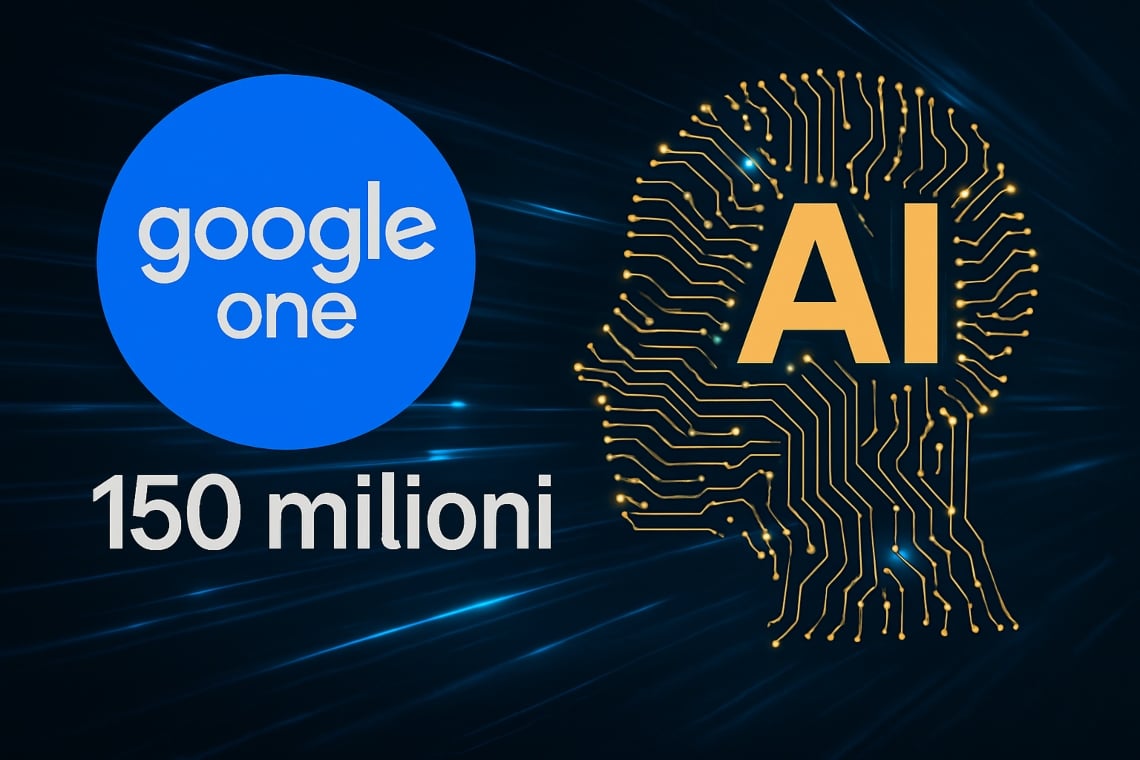Google One has surpassed 150 million subscribers, demonstrating how central Alphabet’s transformation towards AI-powered services is.
This result, achieved in May 2025, demonstrates a significant acceleration compared to the 100 milioni di utenti of February 2024.
The growth not only reflects the success of a strategy based on flexible offerings, but also underscores the increasingly crucial role of abbonamenti digitali in response to the profound changes in the global technological ecosystem.
An Unprecedented Growth: Google One’s Numbers on AI
Google One, cloud storage service and platform of additional services by Alphabet, has reached an important milestone: 150 million subscribers.
This data highlights a growth of 50% in just over a year, driven largely by the launch of new subscription tiers, especially the premium one at $19.99 per month, which integrates exclusive artificial intelligence features.
Despite the offering of more accessible plans remaining central in the Google One ecosystem, it is the premium AI tier that signals the more decisive strategy of direct monetization of AI technologies by Alphabet.
In fact, millions of users have already embraced this advanced proposal, consolidating the group’s new business model.
In recent years, Alphabet has strongly focused on diversifying its revenue streams. Historically, over 75% of the total revenue (350 billion dollars in 2024) came from online advertising.
However, the growing adoption of AI chatbots like ChatGPT by OpenAI and Gemini by Google is profoundly altering the ways users search for and access information.
This transition weakens the centrality of traditional advertising. Furthermore, AI platforms do not yet have a consolidated model for advertising, pushing Alphabet and other big tech companies towards strengthening subscription revenues.
The CEO Sundar Pichai stated in February that, after the experience of YouTube Premium, the company will offer more and more dedicated subscription options, emphasizing how the focus for 2025 is directed precisely in this direction.
The driving role of artificial intelligence in Google services
One of the main innovations that has made Google One so attractive in the last twelve months has been the inclusion of tools of artificial intelligence exclusive in the premium package.
This choice not only responds to market evolutions, but anticipates emerging user needs, increasingly attracted by the power of AI to simplify and enhance daily operations.
Furthermore, the success of the AI component of Google One represents a prime example of the rapid evolution of the entire sector: while traditional searches lose ground, especially on mobile devices, the demand for increasingly advanced digital assistants and chatbots grows.
The rise of chatbots like ChatGPT and internal competitors like Gemini is already reshaping the map of digital consumption.
These tools are progressively changing the way users search for and receive answers to their questions, posing a direct threat to Google’s dominance in online searches.
The confirmation comes from a recent statement in the context of a judicial proceeding. An Apple executive admitted that, for the first time, searches on Safari have decreased, also due to the impact of AI tools.
As a result, the large platforms invest in the development of their own solutions, increasing the competitive pressure on Alphabet.
These profound changes in the scenario have also had effects on the financial market. After Apple’s testimony on the contraction of searches, Alphabet lost 150 billion dollars in market value.
This data reflects the sensitivity of investors towards a business model that, for decades, has seen advertising as the main pillar but now must necessarily evolve.
The decisive shift towards subscription highlights how the entire industry is aiming to build new sources of revenue, more resilient to technological changes and revolutions driven by AI.
Price models and strategies for the future
Precisely because the new AI platforms are not immediate receptacles for advertising, Alphabet has chosen to adopt subscription or consumption-oriented models.
This strategy, already widespread on other products like YouTube, allows for user loyalty and ensures steady cash flows even in a context of rapid digital transformation.
In parallel, we observe how other tech companies are also forced to rethink their approach: the intersection between AI and business models represents today one of the hottest points of digital competition.
The milestone of 150 million subscribers reached by Google One does not concern only the platform itself, but reflects a profound transformation of the digital market.
From a simple cloud storage solution, Google One has evolved into a hub for intelligent services, leading the transition towards monetization based on AI and subscriptions.
At the same time, consumers are developing new expectations: they are looking for increasingly personalized, fast experiences based on intelligent tools, profoundly changing the way they interact with tech companies.
The significant jump in Google One subscriptions demonstrates both Alphabet’s rapid response to market changes and the necessity to constantly evolve in the face of competition that aggressively integrates AI.
Alphabet’s bet on a future dominated by AI subscriptions appears today as one of the most concrete responses to the uncertainty of the traditional advertising market.
As artificial intelligence transforms the way people access information and interact with technology, Alphabet finds itself leading – but also chasing – a new digital era.
For users and investors, following the evolution of AI subscriptions could prove crucial for understanding the future dynamics of technological innovation.
